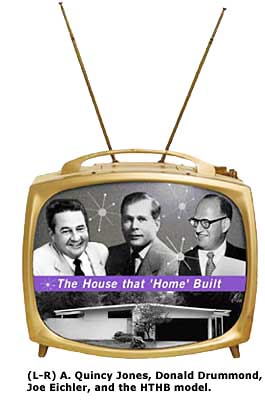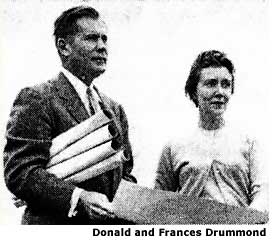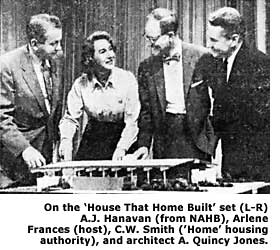The House that 'Home' Built
Eichler homes are as much a part of the California landscape as chaparral and live oak trees. Except for a handful of Eichlers in upstate New York, and the enclaves of look-alikes found mostly on the West Coast, Eichler homes never made much impact on the country as a whole. But for a brief time in the mid-1950s, it looked like they might.

In 1955, thanks to the then-popular NBC television show Home, a design that architectural firm Jones and Emmons originally created for Eichler began popping up in 20 or more cities throughout the United States. Each was built by local merchant builders attracted to the program by the free publicity provided by the popular show, sort of a 1950s version of HGTV. One builder who enthusiastically embraced the program was Donald Drummond, the nearest thing the greater Kansas City area had to a Joe Eichler.
Hosted by actress and entertainment personality Arlene Francis and correspondent Hugh Downs, Home aired weekdays following NBC's Today show. It had two million viewers, mostly women. Its 'House That Home Built' segment, which ran regularly, tried to persuade America that glass-walled, low-gabled, modern homes would work anywhere in the country, not just sunny California.
The 'House That Home Built' was co-sponsored by NBC and the National Association of Home Builders. Housing expertise was supplied by C.W. Smith, director of the Southwest Research Institute's Housing Research Foundation. "We recognize that regional preferences exist," Smith told 'House and Home' magazine in an April 1955 story, "but we want to show people that steep roofs, small windows, and basements in the northeastern part of the country are due entirely to prejudice and habit and are entirely unnecessary technically as well as undesirable from a performance standpoint." Each builder paid $200 for the plans and agreed to build one model to be open to the public. A June 4 deadline was set to coincide with Home's national publicity.

The program was likely the brainchild of Eichler, who hoped the buzz generated by the show would promote his houses. According to an article in that April issue of 'House and Home,' Eichler and Smith persuaded A. Quincy Jones and Frederick Emmons to design the house. The producers' mandate to Jones and Emmons was to design a house appropriate for any climate that could be constructed by builders anywhere in the United States. The program's goal was to show "that an attractive, up-to-date house, embodying principles of good design, can be built at a moderate cost."
Promotion began when a model of Jones and Emmons' design appeared on Home, which was broadcast from New York, on February 28, 1955. Jones realized that what worked for buyers in California might face resistance elsewhere. "We are going to be criticized that it is extreme, but it's not," he said. "Almost everything that's in here we've been doing for ten years." Eichler appeared on the show with Illinois builder Bruce Blietz two days later, and Drummond appeared March 25. Commercial television was only a few years old, but both builders understood its power. "I figured I had about five minutes to sell a thousand houses," Drummond recalled in a recent interview.
'The House that Home Built' was a typical Jones H-plan, with two terraces bordered on three sides by exterior walls. Kansas City Drummond owners call them 'side atriums.' One terrace is adjacent to the public entrance. The other is a private outdoor living area. An open kitchen-living area forms the center of the house, connecting the two legs of the H. Bedrooms fill the rear leg, while a carport and all-purpose room fill the front leg, which faces the street. The bi-nuclear plan successfully separates living and sleeping areas.
The roots of the home reach back to as early as 1951 and Jones and Emmons' plan JE-35 for Palo Alto's Channing Park. By 1955, the architects' designs for models JE-15 (built at Palo Alto's Greenmeadow), MC-55 (Terra Linda), JE-85 (Sacramento), and SM-133 (San Mateo Highlands) all closely resembled the final HTHB design.





